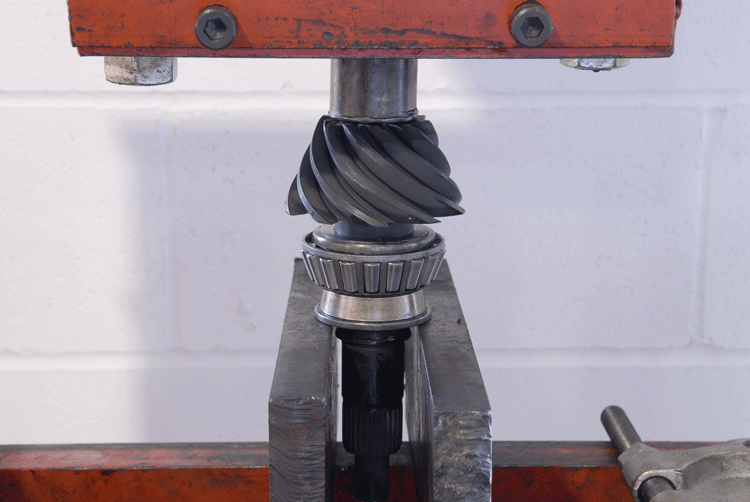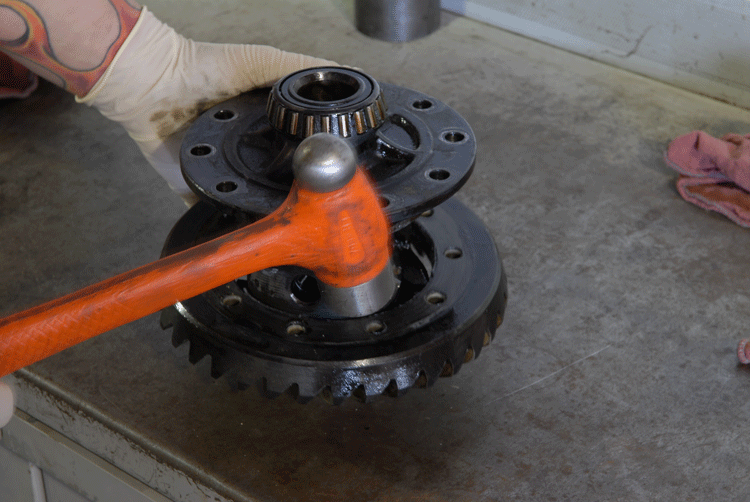Installing Standard Gears in a Ford Irs 8.8
By Travis Thompson Swapping gears is one of the first functioning upgrades recommended for a number of fast (and one-half-fast) cars, and for good reason—it gives you a great seat-of-the-pants comeback. Nowhere is this more than true than in late-model Ford Mustangs, most of which Ford sold with 3.08:ane and 3.27:1 gears. Truthful, 2003–2004 Mach 1s and SVT Cobras did come with three.55:1s, which is a borderline acceptable performance gear, but with modernistic overdrive transmissions, there's actually no alibi not to have something more ambitious. This is particularly true with 1996–1998 Cobras, which don't tend to be every bit torquey as some other Mustangs. Since my 1996 Cobra had traveled over 100,000 miles by the time I decided to bandy in some new gears, I ended upwardly but having the whole rear finish rebuilt. Dan Wolfson of DB Performance swapped in my new gears, rebuilt the Traction-Lok differential, and replaced all the bearings and seals. Dan swapped in a set of Ford Racing iv.ten:1 gears, freshened upwardly my Traction-Lok with Ford Racing'southward new carbon fiber rebuild kit, and added an aluminum rear-end girdle (rear encompass). If you're mechanically inclined, or you have a buddy who has washed this earlier, there's no reason you lot can't exercise a lot of this stuff in your garage. Utilise the step-by-footstep instructions below to guide yous. Unfortunately, I can't tell you if the carbon fiber friction discs were an improvement over the standard discs, as my aged Traction-Lok was completely worn out and thus provided no footing for comparison. I can tell you lot that having a working Traction-Lok fabricated a world of difference, particularly around corners and in the rain. The 4.10s also did their job, giving a huge comeback in get up and go, merely making information technology harder to get out of the pigsty cleanly. If you're serious well-nigh elevate racing, though, you lot'll probably have drag radials or slicks to assistance you launch more effectively. Effectually town and on the highway, the 4-valve Cobra engine had no problem living with the four.10s. In fact, if I wasn't planning on making more power in the future, I might fifty-fifty take installed iv.30s. If your 5.0L or 2-valve 4.6L engine makes more torque than top-end power, yous might desire to go with iii.73:1. The decision is up to you.

The first step is to remove your wheels. Dan pointed out that one slider on my passenger-side caliper had been drilled out, probably because it was stuck in place. Of course that means the grease will dry out and the caliper will soon exist locked upwardly again.

Remove the caliper and then the caliper bracket.

It had been awhile since my rotors were off, so they required a piffling motivation to come loose. The rotors demand to come off so yous can remove the axles in a few steps.

Put drain pain underneath the rear end and remove the rear cover.

Let the dirty former fluid drain into the pan. Dan sprayed the whole affair out with restriction cleaner again and over again, scraping the runoff out of the lesser of the housing.

Remove the pinion shaft retainer commodities and then the pinion shaft. Pop out the C-clips that concord the axles in place.

Before you slide out the axles, remember to disconnect the ABS sensors and remove them. Dan allow me know that these plastic sensors are rather fragile and often intermission (he got mine out without damage).

Slide the axles out carefully. Dan slid the axles through a towel to go along the muddied fluid off the floor. Despite the miles, my axles were in great shape. Of form I'm not making any power and I've just been to the elevate strip once!

The differential is held in place by two stop caps, non unlike the main caps that agree the engine's crankshaft in the block. An impact wrench is handy in taking these out. Keep the caps and the bolts organized so you can reinstall them in the correct positions.

The differential comes out as a unit; bearings, races, and all. Be careful; it's dirty, slippery, and heavy.

This is how the races for the carrier bearings sit down in the housing. You lot can see how they're held in place by the end caps.

Remove the driveshaft to gain access to the pinion nut and flange. Don't drib it on your head.

Remove the pinion nut.

You lot'll demand to use a 3-jaw puller to remove the pinion flange.

Next you tin can pull out the pinion gear, complete with the rear pinion bearing. Despite beingness well used, it was in fine shape.

Here's a look at the nearly empty rear-end housing. You can come across front pinion bearing still located all the way in the front of the housing.

Tap the front pinion bearing out through the back of the housing.

Here'south a look at ane of the axle bearings and seals. Mine looked fine, but it makes sense to replace everything while y'all've got it apart.

A slide hammer comes in handy for removing the axle bearings and seals.

With the bearings and seals out of the way, y'all tin can clean out the rest of the axle housings. Dan cleaned it out by pulling shop rags through the beam tubes and using a lot of brake cleaner.

If you've never seen a muddied axle before—this is what they look like. Discover the splines and the grooves for the C-clips. These are 28-spline axles, but many racers upgrade to 31 or even 33-spline axles for extra strength.

This is Ford'southward complete gear installation kit, complete with all the new bearings, seals, and other miscellaneous parts. You can get less-complete kits for less cash, just it's a good idea to supercede everything y'all tin when yous have information technology all autonomously.

Get-go at the axle ends past setting the bearings in place.

Tap the beam bearings into place.

Carefully install the beam seals.

Here's a look at the empty pinion side of the rear-end housing.

Install the new front begetting cup, begetting, oil slinger, and pinion seal into the housing and tap it securely into place.

Tap the inner pinion bearing cup into the housing.

This Ford tool is used to measure pinion bearing depth. Install the pinion begetting and end caps to test fit the clearances. Add the proper shims betwixt the cylinder and face up of the depth measuring tool until the shims only slide in and out with a picayune elevate.

Dan used a press to install the new rear pinion bearing onto the pinion gear.

With the right shims in place, y'all tin can install the pinion gear into the housing.

Reinstall the pinion flange and torque the pinion nut to spec to 20 inch-lbs of rotational drag. This will ensure the correct pinion bearing preload.

Now on to the differential. Remove all the ring gear bolts so whack the gear loose (if necessary).

Dan removed the carrier bearings with a ii-jaw puller.

It's time to tear autonomously the Traction-Lok. Start by prying out the Southward-spring with a screwdriver. Yous'll be replacing the spring, only try not to nick any of the gears.

At present you should be able to merely rotate the pinion gears out.

Next remove the side gears, complete with the friction discs, steel reaction plates, and shims.

This is what my steel reaction plates (left) and friction discs (left) looked like after 100,000 miles. Detect the grooves worn in the steel plates and lack of friction material on the friction disc. It's safe to say the Traction-Look wasn't doing much good!

This is a new standard friction disc (left) compared to one of Ford Racing'due south new carbon-cobweb friction discs (right). The standard disc has a consistent texture, like sandpaper, while the carbon disc has a much rougher feel. The guys at Ford Racing claim these new carbon discs are more durable, especially in high-horsepower or racing applications.

This is Ford's recommended lodge for the friction and steel plates. For reference, from right to left it goes steel, friction, steel, steel, friction, steel, friction, and shim. Some builders recommend different orders and fifty-fifty extra parts for a tighter differential, merely I oasis't heard if these methods work with the new carbon fiber friction plates. Be careful to keep each ready of discs, plates, and shims together, as they come up measured and matched from Ford.

Soak the friction discs in a combination of Friction Modifier and gear oil for a total xv minutes as per Ford's instructions.

While the friction discs were soaking, Dan installed the first of the two carrier bearings.

The second of the carrier bearings is pressed into identify.

Install the sets of friction discs, steel reaction plates, and shims onto the side gears. These assemblies are sometimes referred to equally the clutch packs. Remember to keep the matched sets together.

Install one of the clutch packs and side gears into each side of the differential.

Rotate the pinion gears into place. They should spin correct in.

You tin can either use a rubber hammer to forcefulness the leap into place, or compress it in a vice or pliers and force it in. This completes the Traction-Lok associates.

Bolt the band gear back onto the differential. Tighten each commodities to 70 to 85 ft/lbs of torque while using a crisscross pattern. Use a vice to concord the differential steady.

Set the differential back into identify, complete with its carrier bearings and races. Reinstall the caps and their bolts dorsum where you got them, and torque the cap bolts to 70 to 85 ft-lbs.

Check the backlash using this dial indicator. Agree the pinion in identify and rock the ring gear back and along and read the measurement. Ford recommends 0.008 to 0.012 inch of backlash. If you take too much backlash, yous desire to add together side carrier shims to the driver's side and remove them from the passenger side. If you have too little backfire, yous desire to exercise the contrary.

Carefully reinstall the axles without damaging those outer seals.

Reinstall the pinion shaft and its retainer commodities.

Ford recommends torquing the new pinion shaft retainer bolt to 23 ft/lbs. Don't forget to reinstall the C-clips to hold the axles in identify.

This is Ford Racing's aluminum axle girdle/rear-end cover (K-4033-G1). Prep it by sealing the drain and fill plugs with Teflon paste.

Make clean off the mounting surface for the rear cover. Dan forgoes the embrace gasket in favor of a dewdrop of Permatec.

Carefully install the axle girdle, being mindful not to smear the silicone. Torque the outer bolts to 20 to 25 ft-lbs in a crisscross pattern.

This thick aluminum cover adds strength to the rear-cease housing itself, but these special load bolts also support the finish caps that concord the differential, which are nether serious stress. Torque the load bolts to 5 to 10 ft/lbs, and and so torque the jam nuts to 25 to 30 ft/lbs. Be conscientious non to over-tighten either of these or y'all could damage the carrier bearings.

Don't forget to fill'er upwards before you bulldoze away. Dan filled the rear end with Majestic Majestic constructed 75W-140 fluid up to the fill-hole in the front of the example.

Finally, reinstall the driveshaft, rotors, calipers, and wheels. Now yous're washed. Some people recommend breaking in your new gears by getting them up to operating temp, letting them cool down completely, and then taking it piece of cake for a couple hundred miles. Others only gyre the car onto the trailer and head to the track. I'll let you decide.
Sources DB Operation Ford Racing Performance Parts
(763) 428-9882
www.dbperformancetuning.com
800-FORD-788 (367-3788)
www.fordracingparts.com
DOWNLOAD HERE
Installing Standard Gears in a Ford Irs 8.8 UPDATED
Posted by: charlestworet.blogspot.com